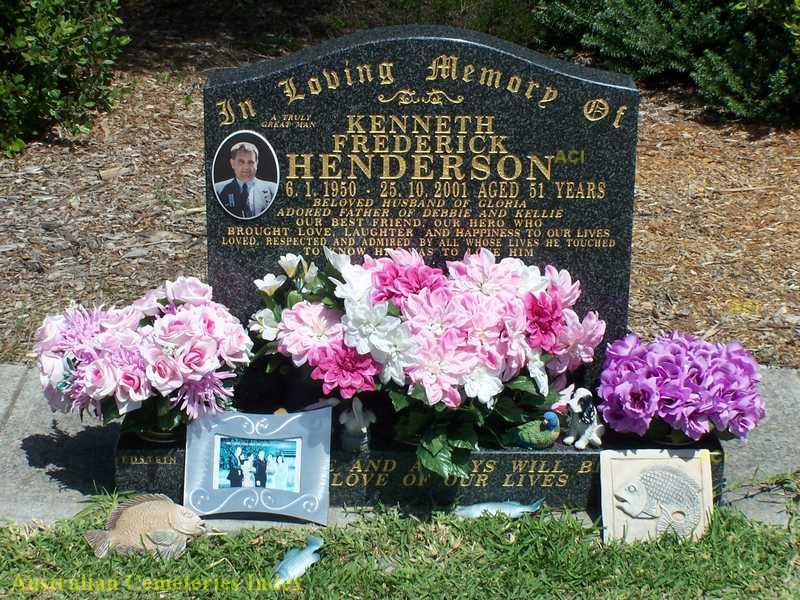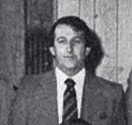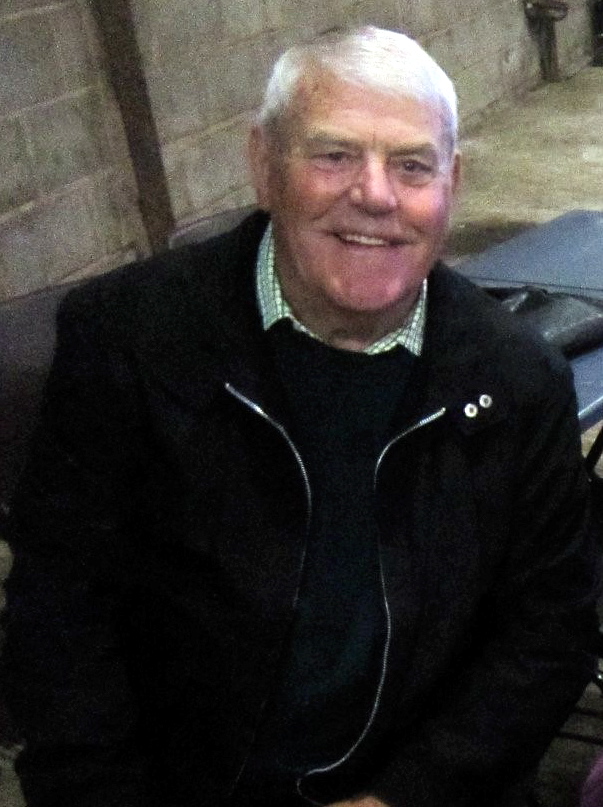Kenneth Frederick HENDERSON
Kenneth Frederick HENDERSON
Late of ?
New South Wales Police Force
[alert_yellow]Regd. # 14078[/alert_yellow]
Rank: Probationary Constable – appointed 26 March 1970
Constable 1st Class – appointed 26 March 1975
Sergeant – appointed 20 November 1985
Detective Chief Inspector – Death
Stations: ?, Charlestown – Death
Service: From ? ? pre March 1970? to 25 October 2001 = 31+ years Service
Awards: National Medal – granted 14 July 1977
1st Clasp to National Medal – granted 2 December 1995
Born: 6 January 1950, Waratah, NSW
Died on: Thursday 25 October 2001
Age: 51
Cause: Suicide – Firearm – Service revolver – within Charlestown Police Station ( in the outside toilets )
Event location: Charlestown Police Station, 25 Smith St, Charlestown
Event date: Thursday 25 October 2001
Funeral date: Wednesday 31 October 2001
Funeral location: Newcastle Christ Church Cathedral, 52 Church St, Newcastle
Funeral Parlour: ?
Buried at: Buried at Belmont Cemetery, Green St, Belmont
Memorial located at: ?
[alert_red]KEN is NOT mentioned on the Police Wall of Remembrance[/alert_red] * BUT SHOULD BE
[divider_dotted]
Grave’s approximate location: [codepeople-post-map]
[divider_dotted]
FURTHER INFORMATION IS NEEDED ABOUT THIS PERSON, THEIR LIFE, THEIR CAREER AND THEIR DEATH.
PLEASE SEND PHOTOS AND INFORMATION TO Cal
[divider_dotted]
May they forever Rest In Peace
[divider_dotted]
Detective Chief Inspector Ken HENDERSON, 51 old, committed suicide by using his service firearm inside the grounds of Charlestown Police Station in October 2001.
Ken was being harassed and ultimately threatened by SCIA during their malicious reign with a personal exposure that would, no doubt, hurt his family. Nothing to do with misconduct on his behalf, just a maliciously attempt to hurt him and his family.
He took his life with his service revolver at the rear toilets of the police station immediately after receiving a phone call from SCIA.
It is believed that no Inquest was held into his suicide.
[divider_dotted]
Three investigated police attempt suicide
By Candace Sutton
March 2 2003
The Sun-Herald
Three police officers investigated by the controversial Operation Florida corruption probe have attempted suicide, The Sun-Herald has learnt.
This follows the death in 2001 of Detective Chief Inspector Ken Henderson, a highly commended officer regarded as a top criminal investigator. Henderson, 51 and a 30-year veteran of NSW Police, shot himself at work in 2001.
There was no suggestion that he was tainted by corruption.
Three officers who came under the operation’s scope have since tried to end their lives.
Senior police officers named on a controversial warrant issued as part of Operation Florida have engaged prominent barrister Tom Hughes, QC.
The warrant, ordered by former assistant commissioner Mal Brammer, was issued the day before the 2000 Olympics began and had 116 names on it.
Those named included a barrister, a journalist and five of Crime Agencies’ nine superintendents. A Police Integrity Commission investigation of the warrant has since found two of the names on it were unsupported by applications or affidavits, which PIC inspector Merv Finlay described as “a minor irregularity”
[divider_dotted]
Why cops took their eye off the streets
March 2 2003
An internal police investigation targeting corruption has claimed victims who weren’t even in its sights, Candace Sutton writes.
On a spring day in September 2000, when a rape gang was carrying out its evil in south-western Sydney, police among the highest echelons of the NSW force were intent on issuing a warrant for a listening device to eavesdrop on fellow officers.
It was a peculiar sort of warrant, with 116 names on it.
The names included those of drug dealers, armed robbers, a barrister, a journalist and five of Crime Agencies’ nine superintendents. Two names were unsupported by the affidavits usually needed for such a warrant.
It was the day before the Olympic Games opening ceremony and with the warrant’s issue, Operation Florida was born, one of the NSW Crime Commission and the Police Integrity Commission’s most explosive joint investigations.
The existence of the rape gangs was only beginning to be known by NSW police and the existence of the warrant was a secret to all but a few deep within the police service.
Like its namesake in the US, is there something rotten in the state of Florida?
The destruction the operation has wreaked in its path – the suicide of one police officer and the attempted suicide of three other officers who were subjects of the investigation – is compounded by the fact that one of Florida’s principal investigators and the man whose work instigated the operation are now themselves under a cloud.
Detective Chief Inspector Ken Henderson, 51, died by his own hand on his service revolver at his own police station at Charlestown.
Just what Florida achieved in uncovering corruption – and it did reveal serious breaches among officers in Sydney’s Northern Beaches – must be affected by these events. Mal Brammer has been accused of conducting malicious investigations in another operation.
During his time in charge of Internal Affairs, Mr Brammer was responsible for gathering the initial evidence for what became the Florida inquiry.
Brammer, who had left the police service for the Independent Commission Against Corruption, resigned from that job last week and faces accusations that he used “malicious and unfounded investigations against individuals”.
Brammer‘s right-hand man in Operation Florida, John Dolan, is suspended from the police service and has to show why he should not be dismissed. ( 181D )
This week the good citizens of NSW might wonder whether what is, at best, the super-zealotry of the police watchdogs, has overridden the force’s principal function: to control crime. Has there been an abuse of power? After all, who’s watching the watchers?
Dolan was allegedly caught drink-driving behind the wheel of a State Crimes Commission car at Killarney Vale, near Wyong, while on holiday, on December 28, 2001. He was charged with having a prescribed concentration of alcohol of .075.
The matter went before the court three times, although Dolan never appeared and a doctor’s certificate said the officer was “unfit to work or attend court or to read and complete documents until further notice”.
The matter was then dropped.
The drink-driving charge was incurred at the height of the Florida probe and there must have been a fear it could affect the integrity of the investigation, a joint effort between the police service, the NSW Crime Commission and the Police Integrity Commission which absorbed considerable resources of all the agencies. Dolan, 43, a senior sergeant, is suspended on superintendent’s pay, though as an acting superintendent he had not passed the examinations for that rank.
Dolan has followed Brammer throughout 15 years in the force, from the Drug Enforcement Agency through drug taskforces to Internal Affairs, and on to Florida. Now Florida itself is being investigated.
A brief of evidence on Ken Henderson’s death will be placed before the coroner soon, although there is concern that only local Gosford police investigated, whereas a policeman’s suicide usually warrants a top-level inquiry.
The listening-device warrant is now the subject of planned legal action by commissioned officers whose names were on the list.
The warrant has been explained on 60Minutes by former police commissioner Peter Ryan, who said an Operation Florida operative was to wear the listening device at a function at which the 116 names were to attend.
The police planning legal action over the warrant say all officers were on duty, and therefore attending no common social functions, during the Olympics.
Police Integrity Commission inspector Merv Finlay, who investigated complaints about the warrant, conceded there was a “minor irregularity”, given two names on the warrant were not named in any application or affidavit.
Senior police officers say the force is sick of the approach taken by some PIC investigators.
“The vast majority of police have no sympathy for officers like [corrupt Manly detectives] Matthew Jasper and David Patison, but we do ask investigators to follow the rules,” an officer said.
Several meetings at State Crime Command have moved to address the issue. A unanimous motion at the biannual conference directed the Police Association executive to pursue the matter hotly.
As for the citizens of NSW, those with their names on the warrant list have asked for access to the affidavits supporting the warrant.
Two years after the now-discredited counter-terrorist squad, the Special Branch, was disbanded, Premier Bob Carr trumpeted the fact that he was opening the secret police files to any citizen who had one.
To date, however, access to the affidavits for the Florida warrant has been denied.
http://www.smh.com.au/articles/2003/03/01/1046407802938.html
[divider_dotted]
Mud sticks to the edges of city on the lake
November 18, 2006
THE latest child sex charges against the former Labor minister Milton Orkopoulos and his campaign worker Pat Roughan have focused attention on Lake Macquarie Council and the effectiveness of local police.
The council has had its fair share of scandals.
In 1996 a former mayor, Doug Carley, was convicted of indecently assaulting a 15-year-old boy. Carley maintains his innocence, saying he did not have the money to contest the offence. He also suffers from bipolar disorder, which colleagues believe was relevant to his case.
In 2002 a former Labor councillor, Chris Foteff, left after gay and bestiality pornography was discovered on his council-supplied computer.
It was found only after the council engaged PricewaterhouseCoopers to follow the porn trail, which led to the recovery of 5000 images deleted from Foteff‘s laptop, including 10 of naked children and about 250 of acts of bestiality.
An earlier police investigation found no images that warranted prosecution. It appears the police decided not to send the computer to Sydney for technical analysis, relying only on what they could retrieve and copy themselves.
An internal police investigation ordered by the then commissioner, Peter Ryan, cleared them of any wrongdoing.
Mr Foteff, who had followed Orkopoulos onto the council as a Labor councillor, has always maintained his innocence and said he was the victim of a set-up.
But reopening the investigation after the PricewaterhouseCoopers report proved difficult because the officer who initially investigated the pornography find, Detective Chief Inspector Ken Henderson, committed suicide in October 2002.
The Mayor of Lake Macquarie, Greg Piper, recalls that police could not prove beyond reasonable doubt that the images on Mr Foteff‘s computer were of “under-age” men and they were also restricted by a statute of limitations.
It was reported at the time that Inspector Henderson shot himself with his service revolver at Charlestown police station soon after receiving a mysterious phone call.
He had recently returned from a trip to Sydney on official police business, believed to be connected to a Police Integrity Commission inquiry. There was no suggestion that Inspector Henderson was under investigation for corrupt conduct but because there was no inquest it remains a mystery.
Cr Piper said he did not believe that those incidents or the charges against Orkopoulos had harmed the council’s reputation, although the incidents were “unfortunate”. “The reality is, they have occurred over a long period of time,” he said, and if people “cast back and clump them together” it made the situation look worse than it was.
However, there had been other complaints about police inaction on child sexual assaults at the Lake Macquarie Local Area Command. In March 2001, Senator Bill Heffernan read a letter from a Charlestown woman into Hansard, detailing her concern about the lack of action taken by police against the abusers of her sons.
That the abuse had occurred was not questioned; her nine-year-old son required surgery after the abuse.
“No charges have ever been laid,” she wrote. “After three years of investigation from the Ombudsman’s office, Mr Bruce Barber [sic], finally intervened and asked for an investigation as to why no interviews and charges have ever been laid in relation to this.”
The mother, who has since moved to Queensland, said Inspector Henderson had been in charge of her son’s case.
[divider_dotted]
DNA On Killer’s Trail
Newcastle Herald
Tuesday July 24, 2001
RAPID advances in DNA technology could hold the key to catching the killer of Swansea High schoolgirl Bree Jones.
Police have reopened the case more than six years after Bree’s body was carried from the Caves Beach house where she had been dead for hours.
Two Lake Macquarie detectives are again working full-time to solve the mystery that has haunted parents across the region since June 3, 1995.
Bree, 16, a Year 10 student, was found dead in a house at Caves Beach after someone drugged her with methadone to have sex with her.
The case spawned two separate inquests, in which coroner Col Elliott called for perjury charges to be laid against several witnesses, and scrutiny of the State’s methadone program.
Parents shuddered as the story unfolded and they realised what had happened to Bree could as easily happen to their children.
Bree fell in with the wrong crowd, rebelled against her parents, ran away from home and paid the ultimate price.
Her mistake was putting her trust in her new `friends’, people who were apparently willing to stand by as one of their number preyed on the teenager for sex.
Bree Jones died half a kilometre from the Caves Beach home where she had lived happily with her parents, brother and four sisters until a week before the tragedy.
`There were 14 people there when she died but no-one knew what happened,’ her father, Wayne Jones, said.
`They knew of course but no-one would say anything.’
As the facts surrounding Bree’s death emerged, her parents’ anger and the frustration of the investigating officers grew.
Left-handed Bree bore injection marks in her left arm where someone, allegedly a man who wanted sex, had injected her with methadone in the early hours of June 3.
`They were trying to get her out of it so they could have sex with her,’ the mother of one of the people at the party told Mr Elliott.
The dose of methadone killed the teenager.
She slipped into unconsciousness and died.
No-one called the ambulance until 1.47pm that day, hours after Bree’s death.
No-one has come forward with exact details about her last hours.
The sperm, scientific police took from her body revealed she had had sex in the 24 hours before her death.
It may now play a pivotal role in the investigation.
Police were increasingly frustrated by the web of lies spun around the late-night party and what had happened to Bree.
Stories changed constantly, infuriating them and Mr Elliott, who recommended several witnesses be charged with perjury.
`The lies that have been told to police and the perjury committed in court have not helped the investigation,’ he said when handing down his closing statement in Wallsend Coroners Court in March 1999.
The coroner found that Bree had died from a lethal injection of methadone.
He was unable to establish who was responsible.
He did recommend the case be reopened.
`In the circumstances of this case, where a child has been overdosed with a lawful drug to obtain a sexual advantage and has consequently died, the pursuit of any person responsible and any person lying should be relentless,’ Mr Elliott said.
It was one more disappointment for the Jones family, who had watched helplessly after a man charged with manslaughter and supplying drugs to Bree went free in 1997 after the Department of Public Prosecutions dropped the case.
For her family one of the worst things about the case remains that no-one tried to save Bree.
One man, 20 at the time of Bree’s death, told the inquest he had seen her about 6am on June 3, lying in bed with a 29-year-old man.
`She had saliva coming out her mouth and her breathing wasn’t clear,’ the man said.
He did not try to wake her but got his surfboard and left the house.
`I didn’t realise she was in danger of losing her life,’ the 20-year-old said.
The same witness, who admitted lying to police constantly in the three years since Bree’s death, said the party goers had got together the next night for a `conference’ to get their `stories straight’.
Bree remains alive to those who knew her best.
`She was full of fun, loved life, just tried to make everyone happy,’ her mother, Maree, said.
`Her sisters still talk about her all the time.
`There’s not a day goes by when her name’s not mentioned in this household.’
It has been a terrible time for the Jones family.
A few years after Bree’s death, her only brother, Jabe, needed a kidney transplant.
Wayne Jones was happy to help his son.
It is this spirit that has kept the Jones family united in its search for justice.
`Like most 16-year-olds, Bree loved life,’ Mr Jones said.
`She was probably a bit braver than she should have been at that age and got into a situation she couldn’t control.
`She’d been a good kid all her life then hit a stage where she was giving us a bit of trouble.
`Bree got in with the wrong crowd and began to mix with older people that were just a bit too clever for her.
`We are very hopeful the new inquiry will lead to something and that articles like this will jog a conscience and get someone to come forward.’
The investigating officers believe advances in DNA technology, coupled with new legislation passed through State Parliament this year, could mean the unsolved tag being taken off the Bree Jones files.
`The major reason we’ve reopened the case is that it was a recommendation from the coroner,’ Lake Macquarie crime manager Detective Inspector Ken Henderson said.
`But now hopefully we can enact the new DNA legislation and take samples directly from the suspects.
`Before we had to charge the suspect with an actual offence related to the case before we could take samples but now we don’t have to do that.
`The new legislation gives us the light at the end of the tunnel.’
Though hoping the new inquiry, now under way, will lead somewhere, Mr Jones intends to keep searching for his daughter’s killer.
`Time can be your best friend or your worst enemy,’ the 49-year-old said.
`I’m going to live a long life just to get to the end of all this.’
http://www.webconference.com.au/web-conference-articles/2001/7/24/dna-on-killers-trail/
[divider_dotted]
iii. KEN HENDERSON
Detective Inspector Ken Henderson was attached to Newcastle. In 2001 he took his own life. At the time a number of officers under his control were involved in Police Integrity Commission matters. It was later established that Henderson was not subject to investigation. The family remains at a loss as to why he took his own life. He had not received any treatment nor consulted any medical providers concerning any stress he may have suffered.
http://unionsafe.org.au/wp-content/uploads/2012/09/NileInquirySubmission.doc
[divider_dotted]




